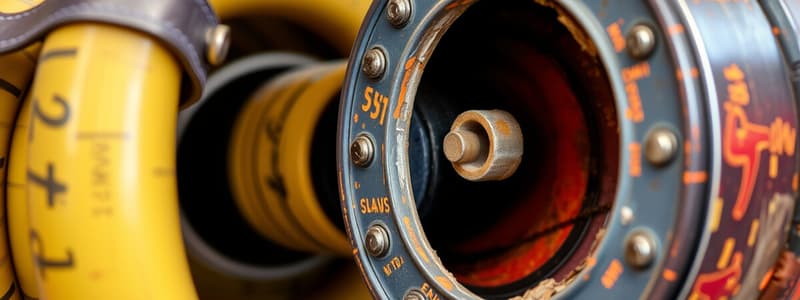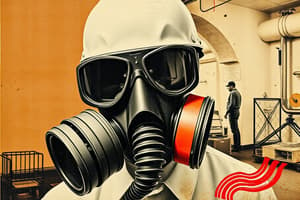Podcast
Questions and Answers
What is the maximum allowable period between tests for hard suction hoses?
What is the maximum allowable period between tests for hard suction hoses?
- 12 months (correct)
- 9 months
- 18 months
- 6 months
What is the testing pressure for rubber lined double jacketed hoses, except one inch?
What is the testing pressure for rubber lined double jacketed hoses, except one inch?
- 400 P.S.I
- 200 P.S.I
- 250 P.S.I
- 300 P.S.I (correct)
What should be done when a section of hose appears to be in unreliable condition?
What should be done when a section of hose appears to be in unreliable condition?
- Leave it until the annual test
- Replace it immediately
- Test it as soon as practical (correct)
- Notify the engineer but take no action
How long must hoses be tested at the required pressure?
How long must hoses be tested at the required pressure?
What is the service test pressure indicated on fire hoses manufactured after July 1, 1987?
What is the service test pressure indicated on fire hoses manufactured after July 1, 1987?
What is the maximum length of the hose line at one outlet during testing?
What is the maximum length of the hose line at one outlet during testing?
What action should be taken for new and repaired hoses after they are received?
What action should be taken for new and repaired hoses after they are received?
What is required when the pressure marked on the hose differs from the Manual of Operation?
What is required when the pressure marked on the hose differs from the Manual of Operation?
What is the maximum allowable horizontal movement of large streams from an aerial ladder?
What is the maximum allowable horizontal movement of large streams from an aerial ladder?
Which method is appropriate for cleaning contaminated hose?
Which method is appropriate for cleaning contaminated hose?
Who should be contacted for instructions regarding hose contaminated with substances that cannot be removed with water?
Who should be contacted for instructions regarding hose contaminated with substances that cannot be removed with water?
What should you do with damaged hose threads or swivels?
What should you do with damaged hose threads or swivels?
What should be done with hose before sending it for repair?
What should be done with hose before sending it for repair?
What marks the location needing repair on the hose?
What marks the location needing repair on the hose?
How should hose be rolled if the female coupling needs repair?
How should hose be rolled if the female coupling needs repair?
How often should rubber lined double jacketed hose be tested?
How often should rubber lined double jacketed hose be tested?
What is the essential practice when carrying hose on apparatus?
What is the essential practice when carrying hose on apparatus?
What is the recommended action for deteriorated hose gaskets?
What is the recommended action for deteriorated hose gaskets?
What should be avoided when using small hard suction hoses?
What should be avoided when using small hard suction hoses?
When picking up hose, what precaution should be taken regarding water damage?
When picking up hose, what precaution should be taken regarding water damage?
What is a key safety procedure when operating hose lines from heights?
What is a key safety procedure when operating hose lines from heights?
Which of the following is NOT a recommended practice during hose line operation?
Which of the following is NOT a recommended practice during hose line operation?
What is an appropriate way to position hose lines that are supposed to be used from ladders?
What is an appropriate way to position hose lines that are supposed to be used from ladders?
What should be done if a hose line is not actively flowing water?
What should be done if a hose line is not actively flowing water?
Flashcards are hidden until you start studying
Study Notes
Hose Operations and Maintenance Procedures
- Follow procedures in Vol. 3, 6/6-01.01, Page 51 for accurate journal entries in F-2 and F-128.
- Ensure all hose coupled on apparatus is secure and orderly.
- Inspect hose gaskets; replace any that have deteriorated.
Specific Hose Types
- Small hard suction hoses assigned to tanks must not endure pressure.
- When "picking up" hose, ensure it’s ready for immediate use and minimize water damage when breaking lines indoors.
Safety Measures for Hose Lines
- Shut nozzles off after attaching to hose lines and ceasing flow.
- Avoid charging hose lines from heights until secured; use ladders or straps for safety.
- Drain water at street level before lowering hoses from heights.
- Prohibit unnecessary water direction at persons or properties.
Testing and Maintenance of Hoses
- Annual testing required for hard suction hoses during pump tests; new or repaired hoses tested post-receipt.
- Testing frequency is maximum 12 months; unreliable hoses should be tested immediately.
- Test pressure varies:
- 300 P.S.I for rubber lined double jacketed hoses (except one-inch), and synthetic nitrile hoses.
- 400 P.S.I for one-inch double jacketed hose.
- Follow N.F.P.A. 1962 standards; service test pressure must be marked on hoses post-July 1987, but the Manual of Operation takes precedence if differing pressures are noted.
Testing Protocols
- Duration of tests should be five minutes at the specified pressure.
- Maximum hose length for testing is 300 feet from one outlet.
- Limit horizontal movement of large streams (2-1/2" or larger hoses) from an aerial ladder to 15 degrees to maintain stability.
Cleaning and Repair Procedures
- Clean dirty hoses using only clear, cold water; consult with Supply and Maintenance Division for substances that resist cleaning.
- Repairs handled by Supply and Maintenance; personnel must not attempt repairs on hose threads or swivels.
- Damaged hoses should be clean, dry, rolled, and properly tagged with repair needs for handling.
- Small burns do not classify as damaged; ensure to test hoses per protocols before repair requests.
Hose Marking and Tagging
- Indicate damage with black tape and roll hose with the female coupling as the core; male coupling as core only if the female needs repair.
- Attach F-175 tag detailing the issue; clarity is essential (e.g., hole 10' from male coupling).
Studying That Suits You
Use AI to generate personalized quizzes and flashcards to suit your learning preferences.




